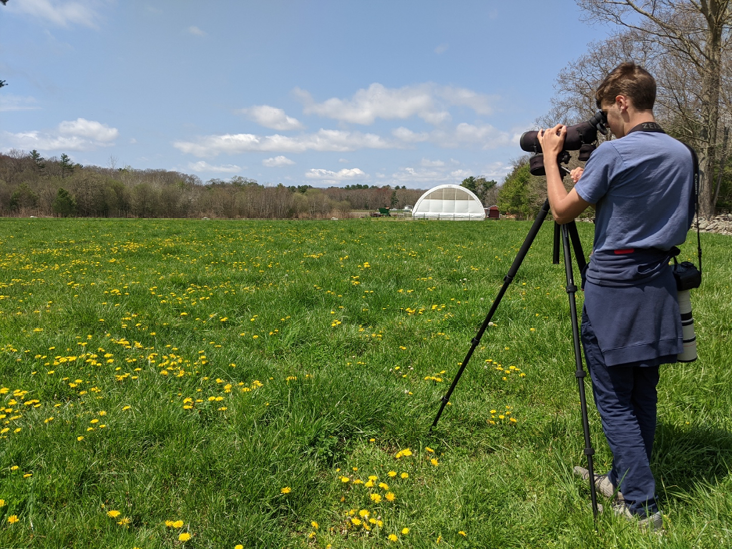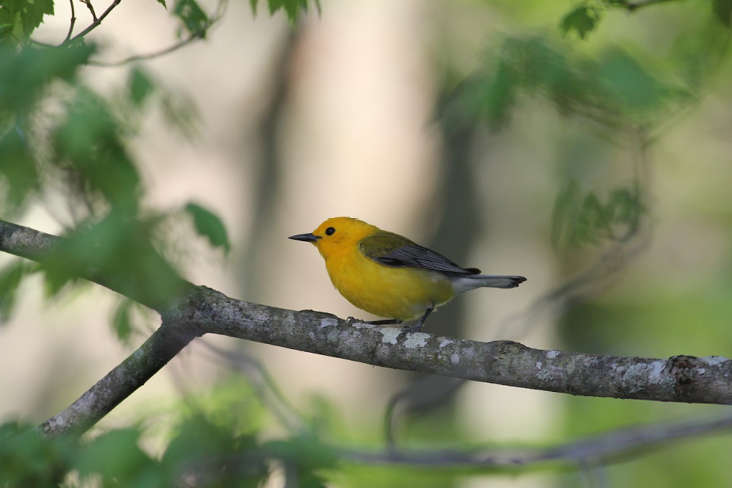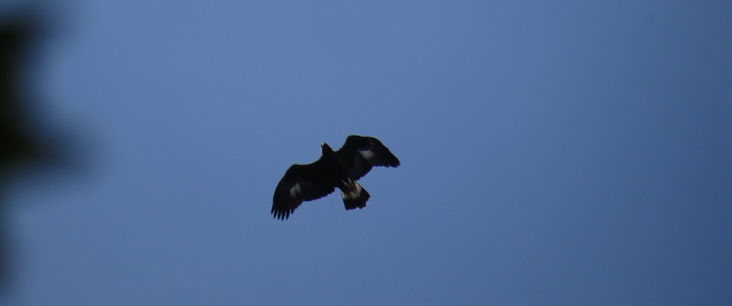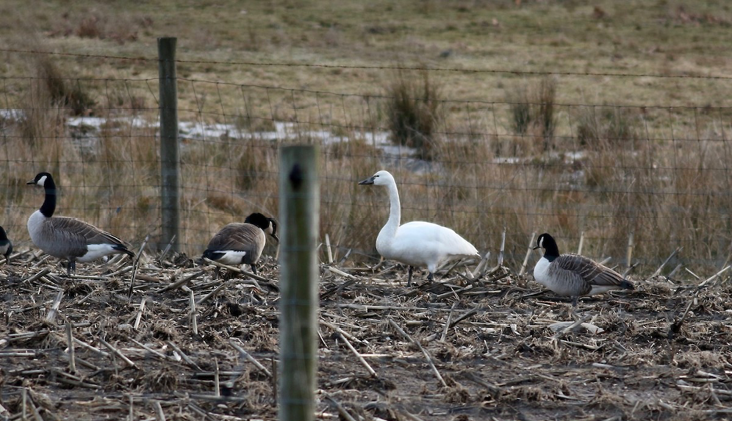Andy Eckerson

Joel scopes the southern horizon on a spring sky watch session. Photograph by the author.
On a sunny afternoon in April 2011, we four Eckerson brothers—Jonathan (then 12), Matt (then 10), Joel (then 9), and I, Andy, (then 11)—began documenting the bird species within our local patch, Oak Top. With four sets of eyes and ears almost always present for several years, we have documented a variety of exceptional records and sightings at Oak Top. The "Oak" is derived from the abundance of oak trees on the property and the "Top" is derived from an elevated vantage point that overlooks the private farm portion of the property. Oak Top is a combination of three parcels in Dighton, Massachusetts: our home, a private cattle farm, and a section of town property. The combination of these three parcels covers over 150 acres of land with several different habitats.
This particular area of southeastern Massachusetts is home to vast hardwood swamps, lush deciduous forests, stands of eastern white pine, and a variety of microhabitats that fill in the rest of the landscape. Oak Top is blanketed by deciduous trees, a small stand of conifers, and a few farm fields. The portion of Oak Top that is town land is a third-growth hardwood forest, made up of mainly northern red oak and white oak trees. This portion was burned over in a 1986 brush fire. Our property hosts an eastern white pine stand covering just over 10 acres. It also has a small field that is bordered by a patch of young deciduous trees. The private farm consists of hay fields, a few small ponds, and an overgrown slough area. The private farm also has a manure pile area that has small pools seasonally.

Prothonotary Warbler. Photograph by Jonathan Eckerson.
All these habitats are instrumental in making Oak Top a special bird magnet. It may appear that Oak Top does not have any geographical or ecological significance such as a coastal location or large body of water, but we think its physical location cannot be overlooked and is key to the high diversity and numbers of birds that frequent or fly over the property. We consider Oak Top a hidden gem and we call our location the overland passageway. Our assumption for the overland passageway is that northbound and southbound birds during migration do not always fly around the arm of Cape Cod but instead fly straight over Bristol County. This would not only save time but precious energy as well. We base this idea on some of the sightings the property has accrued over the years.
Oak Top has a rich records history during the eight years we brothers have actively birded it. The wooded sections of the property have their fair share of notable records. In November 2012 we had an immature Red-headed Woodpecker visit the feeders twice within a few weeks. In May 2013 a singing Yellow-throated Warbler passed through the property. This is one of two records of this species on the property to date. In May 2015, Joel and I came upon a singing Prothonotary Warbler across the street in the maple swamp. It not only proceeded to check out an abandoned Northern Flicker cavity but briefly stopped in the birdbath at our feeder setup. Unfortunately, it was a one-day wonder but everyone able to observe it was satisfied with the absurdly close views.

Golden Eagle. Photograph by Matthew Eckerson.
Although most of Oak Top is covered with deciduous trees, there is a unique opportunity to sky watch from the private farm's fields. Sky watching has yielded a great number of otherwise unexpected species for what seems to be a wooded property. Countless hours sky watching during the spring, summer, and fall have paid off with some quality records over the years. Many of the property's most notable records have been flyovers.
On an overcast day in March 2017, Joel alerted us to a flock of 72 Snow Geese flying directly over the property; they nearly landed in the farm fields. We recorded Sora on a low overcast night in May 2017 while monitoring nocturnal flight calls with a homemade bucket microphone. Two weeks after the Sora record, we recorded a Least Bittern nocturnally, which marked the third Bristol County record. That spring we also had a variety of nocturnal first records at Oak Top such as Short-billed Dowitcher, Whimbrel, Semipalmated Plover, and Upland Sandpiper. In fall 2017, we documented the property's first record of Gray-cheeked Thrush by means of the homemade nocturnal bucket microphone.
On a warm October day in 2017, with strong southeast winds blowing, Matt came running inside to alert us that a Golden Eagle was flying overhead. It circled for a few minutes before disappearing to the northwest. This extraordinary sighting marked the fourth record for Bristol County.
In May 2018, we were not terribly surprised to find two Cattle Egrets that spent the day in the neighbor's field feeding within the cattle herd. On a fall day in late October 2018, Matt had a Dunlin drop into a flooded area of the neighbor's corn field where it foraged for most of the morning.

Tundra Swan in corn field with Canada Geese. Photograph by Joel Eckerson.
One April morning in 2019, Joel found a singing Louisiana Waterthrush in the hardwood swamp behind the slough section of the property. Until recently this species was scarce and under-detected in the county. Over the past few years, though, it has become a regular sighting during spring migration. In 2020, we observed a singing male for weeks at the small stream that runs along the back of the property. Although a breeding pair was not confirmed, there is good reason to expect breeding in years to come.
In late May and early June 2019, the Northeast saw an abundance of Mississippi Kites and it was only a matter of time before Oak Top recorded its first. Sure enough, while we were enjoying a calm May evening, one flew low over the property.
One of the most notable—and memorable—property records came in late August 2019 when Matt and Joel observed a flock of 54 migrating Hudsonian Godwits heading southeast. This record marked the highest count of Hudsonian Godwits in Massachusetts over the past ten years and strongly supports the idea of an overland passageway.
Later during that fall migration, Joel had two property firsts: a flyover Eastern Meadowlark and a Philadelphia Vireo in the slough. Although there are hay fields on the property, none is quite suitable for overwintering meadowlarks due to their shape and general configuration.
Things got crazy on the goose front during the winter of 2019–2020. The towns of Dighton, Seekonk, and Somerset had exceptional numbers of Canada Geese with a Pink-footed and Greater White-fronted Goose in the mix. A Tundra Swan was also hanging out with the Pink-footed Goose and Canada Geese. We closely monitored Oak Top's farm fields for the entire goose season for these unusual geese and, sure enough, one evening we located the Pink-footed Goose with some Canada Geese. Three days later, Joel spotted the Tundra Swan feeding in the corn field with some Canada Geese. In early January, I found a Greater White-fronted Goose at dusk while scoping a flock of Canada Geese.
The most recent notable record occurred in April 2020 when Matt observed a Swallow-tailed Kite. This occurred the day after Jim Sweeney documented a Swallow-tailed Kite in Truro, Massachusetts. There were favorable strong sustained southwest winds, so Matt set up his scope in the hay field with the hope of spotting this rare southern visitor. He was fortunate enough to pick out the kite flying over the southern portion of the property.
We think the overland passageway is an integral part of Oak Top's attraction to migrating birds. For the past few years, we have observed a large flight of scoters migrating north over the property in late May. The majority of these are presumably White-winged Scoters, although Black Scoters were observed during the 2019 flight. During the 2019 flight we estimated 7000 scoters, of which we identified 737 as White-winged Scoters, 110 as Black Scoters, and the remainder as scoter species. We think that these scoters are traveling north from their wintering grounds off Nantucket and southeastern Massachusetts. Instead of exerting the extra effort to travel around the arm of Cape Cod, they take the direct route over the mainland. Although this phenomenon has not been formally researched, this May scoter flight event supports our idea of an overland passageway.
Sky watching paid off in late March of 2017 when Joel and Matt observed more than 3000 Canada Geese flying north during the evening ahead of a huge storm system. Along with the geese were a couple hundred gulls, mainly Herring, that followed the same flight path. We cannot be sure that this concentration of geese over this particular area of the property is directly connected to an overland passageway, but it helps to support this idea.
On May 18th, 2019, Joel attempted an Oak Top Big Day. In just over 15 hours he documented 100 species on the property. This effort is an important event in the property's birding history and will go down as one of the best days of birding at Oak Top. If you bird an area long enough it is possible to be extremely efficient at covering it during peak migration and pulling out fantastic numbers and species.
Oak Top is a prime example of what relentless coverage of a local hotspot or location can produce. What appeared to be a property with little ecological significance has turned into a wildly different story. Every season on the property brings new birds with new surprises and the everchanging possibilities make birding all the more appealing. Whether it is watching morning flight stream overhead on a crisp October day or listening for nocturnal migrants on a cool May night, Oak Top continues to captivate every month.
Andy Eckerson is currently an undergraduate student at the University of Massachusetts Amherst where he studies wildlife ecology with a particular interest in seabird population dynamics. When not engulfed in academia, he enjoys nocturnal flight calls, rock climbing, trail running, and essentially anything involving the outdoors.